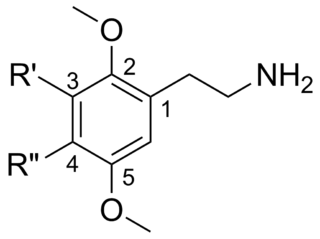
The 5-HT2A receptor is a subtype of the 5-HT2 receptor that belongs to the serotonin receptor family and is a G protein-coupled receptor (GPCR). The 5-HT2A receptor is a cell surface receptor, but has several intracellular locations.

2C (2C-x) is a general name for the family of psychedelic phenethylamines containing methoxy groups on the 2 and 5 positions of a benzene ring. Most of these compounds also carry lipophilic substituents at the 4 position, usually resulting in more potent and more metabolically stable and longer acting compounds.

Xylamidine is a drug which acts as an antagonist of the serotonin 5-HT2A and 5-HT2C receptors, and to a lesser extent of the serotonin 5-HT1A receptor. The drug does not cross the blood–brain barrier and hence is peripherally selective, which makes it useful for blocking peripheral serotonergic responses like cardiovascular and gastrointestinal effects, without producing the central effects of 5-HT2A receptor blockade such as sedation, or interfering with the central actions of 5-HT2A receptor agonists.

YM-348 is an indazole derivative drug which acts as a potent and selective 5-HT2C receptor agonist, with an EC50 of 1nM and 15x selectivity over 5-HT2A, although it only has moderate selectivity of 3x over the closely related 5-HT2B receptor. It has thermogenic and anorectic effects in animal studies, making it potentially useful for the treatment of obesity.

4-Substituted-2,5-dimethoxyamphetamines (DOx) is a chemical class of substituted amphetamine derivatives featuring methoxy groups at the 2- and 5- positions of the phenyl ring, and a substituent such as alkyl or halogen at the 4- position of the phenyl ring. They are 4-substituted derivatives of 2,5-dimethoxyamphetamine.

Adatanserin is a mixed 5-HT1A receptor partial agonist and 5-HT2A and 5-HT2C receptor antagonist. It was under development by Wyeth as an antidepressant but was ultimately not pursued.

JTE 7-31 is a selective cannabinoid receptor agonist invented by Japan Tobacco. It is a reasonably highly selective CB2 agonist, but still retains appreciable affinity at CB1, with a Ki of 0.088nM at CB2 vs 11nM at CB1.

AZ-11713908 is a drug developed by AstraZeneca which is a peripherally selective cannabinoid agonist, acting as a potent agonist at the CB1 receptor and a partial agonist at CB2. It has poor blood–brain barrier penetration, and so while it is an effective analgesic in animal tests, it produces only peripheral effects at low doses, with much weaker symptoms of central effects compared to other cannabinoid drugs such as WIN 55,212-2. Many related benzimidazole-derived cannabinoid ligands are known.

Substituted tryptamines, or simply tryptamines, also known as serotonin analogues (i.e., 5-hydroxytryptamine analogues), are organic compounds which may be thought of as being derived from tryptamine itself. The molecular structures of all tryptamines contain an indole ring, joined to an amino (NH2) group via an ethyl (−CH2–CH2−) sidechain. In substituted tryptamines, the indole ring, sidechain, and/or amino group are modified by substituting another group for one of the hydrogen (H) atoms.
5-HT2C receptor agonists are a class of drugs that activate 5-HT2C receptors. They have been investigated for the treatment of a number of conditions including obesity, psychiatric disorders, sexual dysfunction and urinary incontinence.

25CN-NBOH is a compound indirectly derived from the phenethylamine series of hallucinogens, which was discovered in 2014 at the University of Copenhagen. It is a member of the NBOMe family of psychedelics.

Tanaproget is an investigational nonsteroidal progestin. It is a high affinity, high efficacy, and very selective agonist of the progesterone receptor (PR). Due to its much more selective binding profile relative to most conventional, steroidal progestins, tanaproget may prove to produce fewer side effects in comparison. As of December 2010, it is in phase II clinical trials in the process of being developed for clinical use as a contraceptive by Ligand Pharmaceuticals.

QMPSB is an arylsulfonamide-based synthetic cannabinoid that has been sold as a designer drug.

The 25-NB (25x-NBx) series, or NBOMe series, also known as the N-benzylphenethylamines, is a family of serotonergic psychedelics. They are substituted phenethylamines and were derived from the 2C family. The most commonly encountered NBOMe drugs are 25I-NBOMe, 25B-NBOMe, and 25C-NBOMe.

SCHEMBL5334361 is a drug which acts as an agonist at the 5-HT2 family of serotonin receptors, and was developed for the treatment of glaucoma. It is a benzazepine derivative structurally related to the anorectic drug lorcaserin. It is selective for 5-HT2A, with an EC50 of 0.4nM at 5-HT2A vs 3.9nM at 5-HT2C and a much lower affinity of 417nM at 5-HT2B.

O-1656 is a cannabinoid agonist which was invented by Billy R Martin and Raj K Razdan at Organix Inc in 2002. It is moderately selective for the CB2 receptor with a CB1 receptor affinity of 18 nM and a CB2 receptor affinity of 2 nM. Since it has a cycloheptyl ring attached to the phenol core, it falls outside the definition of a "cyclohexylphenol derivative", but may still be controlled by generic legislation in some jurisdictions.

7-F-5-MeO-MET (5-MeO-7-F-MET, 5-Methoxy-7-fluoro-N-methyl-N-ethyltryptamine) is a tryptamine derivative which acts as a serotonin receptor agonist selective for the 5-HT2 subtypes, with a pEC50 of 8.71 at 5-HT2A, vs 8.25 at 5-HT2B and 7.69 at 5-HT2C. In animal tests it produced the most potent head-twitch response of a range of related fluorinated tryptamine derivatives tested, though still with slightly lower potency than psilocybin.

ZC-B (3-(4-bromo-2,5-dimethoxyphenyl)azetidine) is a phenethylamine derivative which acts as a serotonin receptor agonist selective for the 5-HT2 subtypes, with an EC50 of 1.6nM at 5-HT2A, vs 5.8nM at 5-HT2C. It is related to psychedelic phenethylamine derivatives such as 2C-B and mescaline but with the ethylamine side chain replaced by an azetidine ring.

Isotryptamine, also known as 2-(1-indolyl)ethylamine, is a chemical compound and positional isomer of tryptamine.


















